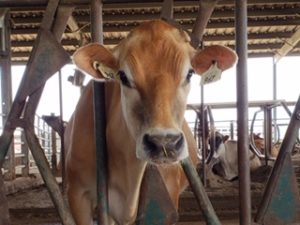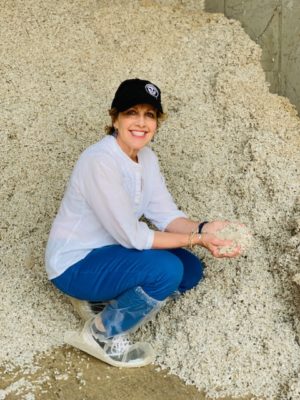June is National Dairy Month! For one who grew up on a dairy farm, I celebrate the dairy farmers of the past, reflecting on previous generations in my family and the instilled work ethic and values gained from my background. But this year, more importantly, I salute the farm families — big and small — that are continuing the tradition of providing one of the most nutritious foods, even when the sentiment of the public is not always in “our” favor. Here are five facts about dairy that I know to be true:

A Jersey cow at White Rock Farms.
Photo by The Dairy Alliance
1. Any type of farming is not for the “faint of heart.” It’s a risky business!
Just ask the Midwest grain farmers looking at their land and profits currently under water. Dairy farmers balance the risks of supply and demand, technology, trade and profitability every day of every year. So why continue? The dairy farmers I know share a passion for their animals and a commitment to society to produce a top-quality product. Recently, I had the opportunity to reconnect with my “roots” at the White Rock Farms in Marshville, North Carolina, during a Dairy Alliance event. There I met one of today’s progressive dairy farmers, Roddy Purser. An economics major with a farm background, Roddy transitioned from beef to dairy farming six years ago to add to the diversification of his family farm and based on his commitment and passion. The transition was not without significant contemplation on how to sustain a dairy while balancing the “triple bottom line” — people/animals, planet and profits. With current pricing and ever-changing trade agreements, scale of profitability depends on farm size. Today, we envision the idealistic farm like the one I grew up on, but the truth is, it wasn’t easy to make any money 30 to 40 years ago on a 40+ herd, and it’s not an option now. Roddy started his operations with a 600 herd Jersey dairy, noting it was “small” by today’s standards and would have to be larger if dairy was his only income.
2. There are no vacations or “closed for the season” options on a dairy farm!
Dairy is a 365 day per year commitment with cows being milked two to three times a day! During my time on the farm, the routine 5 a.m. and 5 p.m. milking times stayed intact for over 50 years. (This explains why I had an afternoon wedding!) But today, research has shown milking cows three times daily is better for the cow’s health and overall improved milk production. For White Rock Farms, this means cows are milked 7 a.m., 3 p.m. and 11 p.m. in a carousel type milking facility. Workers check animal identification and health care status throughout the process with the aid of chip technology, monitors and the human touch, all being viewed through glass windows from the office to the milking parlor.

Marianne with a Jersey cow at White Rock Farms
3. Dairy farmers care about their animals-seriously!
Despite what may have captured the headlines in the past couple of weeks, it’s the care of their animals that forms the foundation for a sustainable herd. At White Rock Farms, the 45-person staff are committed to the care of their cows and calves as evident by the living conditions of the animals and the care procedures in place for the calves to the cows throughout their pregnancy and milking cycles. Nutritionists, dairy scientists and trained workers make up the care team for this dairy. I always said the “four-legged” females came first on our farm and that hasn’t changed with larger herds. It just takes a few more hands to ensure that philosophy is upheld.
4. The dairy industry is committed to sustainability.
Despite the rising battle of plant versus animal protein sustainability, the dairy industry continues to lead the way. Growing up, my family was committed to adopting good practices in animal care, manure management, land and water use. Greenhouse gas emissions weren’t on the radar. Greenhouse gases include water vapor, carbon dioxide, methane, nitrous oxide and ozone. Today, dairy as an industry, and farms individually, have made great strides in reducing their carbon footprint while maintaining high standards of animal care. According to the U.S. Environmental Protection Agency’s U.S. Inventory of Greenhouse Gas Emission Report, dairy production contributes less than two percent of U.S. greenhouse gas emissions. In fact, producing a pound of milk takes three times less methane than it did in 1924 because of the many efficiencies practiced by dairy farmers. Today, U.S. dairies are producing almost three times more milk with about half the number of cows as in 1960.1 Better technology and animal science practices make the difference.
5. Regardless of whether it’s organic or conventional, all milk is nutritionally the same and safe.
Overall, milk and milk products are a real bargain for the ultimate nutrition boost they provide. Regardless of the protein content of alternative milk-like beverages and products, the best buy for your money is a dairy-based product. No other option provides the protein, calcium, vitamins and minerals in the same quantity and package without adding any ingredients (except Vitamin D). And when it comes to safety, no milk is ever shipped from a dairy farm for processing with pesticides or antibiotics! Strict testing for both occurs on the farm when the milk is picked up and again upon delivery to the processing plant. This is a practice that has always been in place for commercial milk production to ensure safe milk for the public. So, the “no antibiotics” you see on a milk label is true, but it is true for all milk — regardless of the brand, store or type of production.
The Bottom Line

Marianne at White Rock Farms. The farm uses cotton seed waste as feed for their cattle. True “sustainability in action”! Photo by The Dairy Alliance
It’s not easy to be a dairy farmer and those in the business today are committed to providing quality care for their animals to ensure the best product is produced in the most sustainable way. And it’s more than the core of the business. It’s a passion and commitment as seen at White Rock Farms and other dairies I have visited over the years. Headlines about dairy animal care may lead us to question that commitment or even to skip the dairy section of the grocery store, but the truth is never what it seems at first glance. From my experience, when badpractices are identified, corrections are made as in any business. A year ago, in my first blog I wrote, “For those of us who have grown up on farms and around agriculture, there was initially a perception that a “common” understanding and trust for farmers and agriculture was inherent and everyone “just understood! But we know that’s not the case.”
Dairy farmers like Roddy Purser understand the importance of opening their doors to the community and telling their story, providing the opportunity to close the gap of understanding and build trust. Perhaps, we all should embrace the philosophy of Atticus Finch, who says in To Kill A Mockingbird, “You never really understand a person until you consider things from his point of view, until you climb into his skin, and walk around in it.” So take time this June to celebrate all things dairy. Enjoy your favorite cheese, yogurt or milk and thank the “ladies” and their care takers for making these products possible.
______________________
References:
1. USDA National Statics Service, https://www.nass.usda.gov
Notes:
I visited White Rock Farms as a speaker for an event sponsored by The Dairy Alliance. My honoraria and travel were paid by The Dairy Alliance. The content of this blog reflects my own thoughts and is not sponsored.
